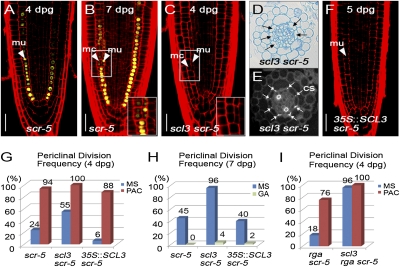Fig. 4.
Control of MC formation by the interplay of the SCL3, SHR/SCR, and GA/DELLA pathways. (A and B) MC formation in scl3 roots marked by pCO2::H2B-YFP. At 7 dpg, scl3 roots showed the additional formative periclinal division giving rise to two ground tissue layers. Arrowheads indicate mutant layer (mu) and middle cortex (mc), respectively. (C–E) Occurrence of the formative division in scl3 scr. The scl3 scr double mutants exhibited uncoordinated formative divisions, which generate an inner layer with the Casparian stripe (CS) and an additional cortex layer. Black arrows indicate the additional formative division (D), and white arrows indicate the Casparian stripe (CS) (E). (F) 35::SCL3 in scr reduced the occurrence of the formative division (at 5 dpg). Quantitative evaluation of MC formation in scr, scl3 scr, and 35::SCL3 in scr in the absence or presence of PAC (G) or GA3 (H). Bioactive GA levels additively or synergistically have influence on MC formation with opposing effects: increase by PAC and decrease by GA3. (I) Occurrence of MC formation in rga scr and scl3 rga scr in the absence or presence of 1 μM of PAC. The scl3 rga scr roots showed a far more increased frequency of the formative division regardless of PAC. (Scale bar, 30 μm.)

